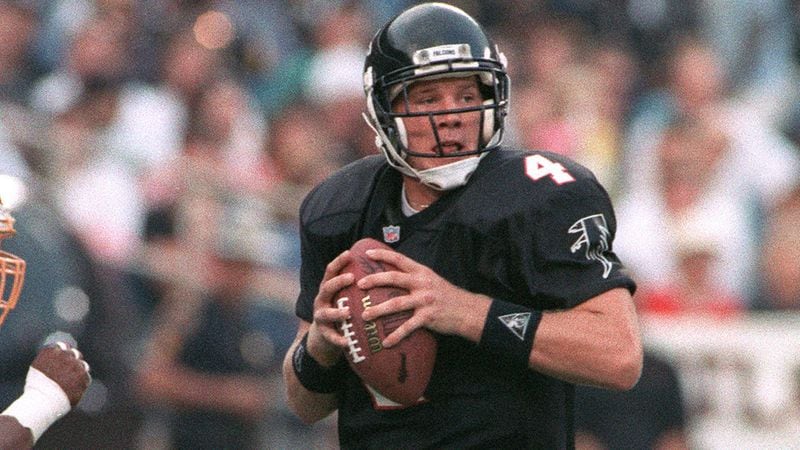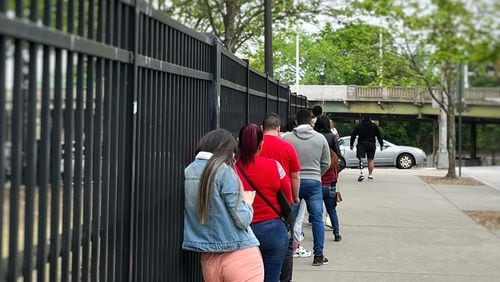FLOWERY BRANCH — After drafting quarterback Michael Penix Jr., Falcons coach Raheem Morris cited “the Green Bay model” as one of the things the franchise considered.
Morris was referring to the drafting of quarterback Jordan Love while the Packers had Aaron Rodgers on the roster. Love was taken in the first round (26th overall) of the 2020 draft.
The Falcons signed Kirk Cousins to a four-year contract worth up to $180 million in free agency. However, that didn’t preclude them from drafting Penix with the eighth overall pick in the draft Thursday.
“For us, it started happening quicker and faster,” Morris said. “The Green Bay model was something we talked about. It’s been proven to be right last year. So hopefully we’ll be right with them.”
Love, after being in a reserve role for three seasons, took over for Rodgers last season and guided the Packers to the playoffs after Rogers was traded to the New York Jets.
The origin of “the Green Bay model” can be traced to the Falcons. After Ron Wolf was named general manager in Green Bay in 1991, the Packers didn’t have a promising quarterback.
Credit: AJC
Credit: AJC
On Feb. 10, 1992, Wolf swung a deal with the Falcons to land Brett Favre to play for coach Mike Holmgren. Since, the Packers have valued the quarterback position like no other franchise.
Holmgren, who’s retired, was a finalist for the Pro Football Hall of Fame as a coach for the class of 2024. He worked with some of the greats from Joe Montana and Steve Young in San Francisco before salvaging Favre’s career.
While with the Packers from 1992-98, the Packers drafted a quarterback in eight of nine drafts even though they had Favre. Wolf was Green Bay’s general manager from 1991-2001. The quarterbacks were developed and then shipped off for draft picks. The list included Mark Brunell (151 starts in the NFL), Matt Hasselbeck (206 starts) and Aaron Brooks (90 starts).
“Every year, I tried to do that (draft a quarterback),” Holmgren told The AJC recently. “Again, it’s different. It’s interesting. I had a philosophy. … When we got Favre and we traded a No. 1 pick. What you are saying to everybody, your fans, everybody, if you do that, he’s going to be your starter. If it’s the first game or the fourth game. You don’t spend a No. 1 pick and then have him watch for a long time.”
In 1994, the Packers had Favre, Brunell, Ty Detmer and Kurt Warner in training camp. Warner was cut and would re-emerge with the Rams in 1998 and make his mark in the league.
Later in 2005, Ted Thompson, a former Wolf lieutenant, drafted Rodgers in the first round with the 24th overall pick, with Favre on the roster. Rodgers sat and learned how to play quarterback for three seasons before making his first start in 2008.
Since Wolf and Holmgren were hired, the Packers have won two Super Bowls, been to the playoffs 23 times and have had just three losing seasons.
“The Packers did that with Aaron Rodgers because they had Brett Favre at quarterback,” said Holmgren, who left for Seattle in 1998. “But Aaron kind of watched for a while.”
The major difference is the Falcons drafted Penix high in the first round.
“The Green Bay model” has roots in the Favre trade, which netted the Falcons a late first-round pick.
“I was speaking more to the previous model, you know, the model when they took Love,” Morris said. “And think of that nature and think of putting the succession plan in the building when it wasn’t a popular choice by anybody, by the fans, by clearly the writers and some of those things.”
The Falcons tried to transition away from long-time starter Matt Ryan by signing Marcus Mariota and Desmond Ridder after they bowed out of the Deshaun Watson derby. The Browns guaranteed a five-year $230 million deal for Watson.
The Falcons had to spend to land Cousins, and Penix’s contract is projected to four-years, $22.8 million with a fifth-year option. So, the Falcons committed $202.8 million to the quarterback position this offseason.
“But I think you’ve got to trust your process,” Morris said. “You’ve got to trust your evaluations of the players. I think you’ve got to be really convicted in the people that you put in place to evaluate the people.”
The Falcons believe Penix eventually will succeed Cousins.
“(You don’t) lose any conviction in the guys that you have in your room like a Kirk Cousins, you have full conviction in those guys to winning the South (division),” Morris said. “Going out taking the South and all the things as a team. All those things still stand in place. But at some point, you know, I wish we all can play forever but we can’t.”
The Falcons accepted the risk involved in the bold quarterback moves.
“If things are going right, things are going right, we’ll be happy in Atlanta,” Morris said. “We’ll be moving forward with Kirk and we’ll see what happens. But we’ve got five years before we got to make those decisions based on the timing that you pick these guys and the timing they go out.”
The Falcons didn’t want to bypass the opportunity to select a quarterback. They don’t have plans like – like Holmgren-Wolf-Thompson -- to keep drafting one nearly every year.
“I’m hoping ... that we’re not in position to pick quarterbacks because we’re not going to pick them low enough, " Morris said. “If we can get to that realm, we’ll be talking about the stuff we want to play with, the gas we want to play with and how we want to play. "
The Falcons made the move at eight when some suggested that they could have traded back and drafted Penix.
“We had a lot of communications about moving back and we talked to a lot of teams, just preliminary talks to assess, but we didn’t have some – we didn’t get a big offer for someone to give up a lot,” Fontenot said. “That wasn’t there. Again, we’re in communication, but there weren’t any offers to come up – any significant offers to come up to our spot.”
AJC’S 2024 POSITION-BY-POSITION DRAFT SERIES
WIDE RECEIVERS -- Don’t sleep on Washington’s Rome Odunze among talented wide receivers | Top 10 WRs
RUNNING BACKS -- ‘Day two is going to be the running back day,’ an analyst says | Top 10 RBs
TIGHT ENDS -- Ex-Georgia standout Brock Bowers is the top tight end | Top 10 TEs
QUARTERBACKS -- After Caleb Williams, is Jayden Daniels or Drake Maye the next quarterback? | Top 10 QBs
OFFENSIVE LINE -- Mims, Van Pran-Granger could help NFL teams in the trenches | Top 5 C, OG, OTs
DEFENSIVE LINE -- T’Vondre Sweat’s recent arrest will impact his status | Top 5 DTs, DEs
LINEBACKERS -- Dallas Turner likes to hit quarterbacks | Top 10 LBs
CORNERBACKS -- Alabama cornerbacks Arnold, McKinstry ready for next level | Top CBs
SAFETIES --Javon Bullard’s instinctive play style should translate well in NFL | Top 10 safeties
SPECIAL TEAMS -- NFL draft: New kickoff return rules to boost special-teams players | Top 10 special
The Bow Tie Chronicles







